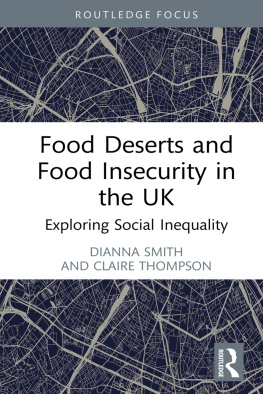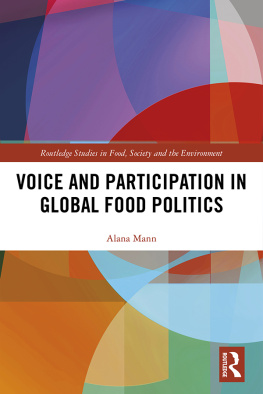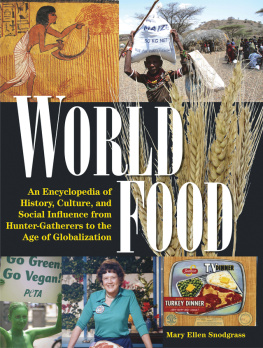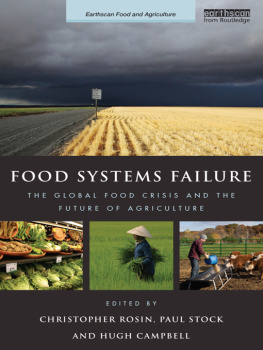Food & Society
Food & Society
Principles and Paradoxes
Amy E. Guptill,
Denise A. Copelton,
and Betsy Lucal
polity
Copyright Amy E. Guptill, Denise A. Copelton and Betsy Lucal 2013
The right of Amy E. Guptill, Denise A. Copelton and Betsy Lucal to be identified as Author of this Work has been asserted in accordance with the UK Copyright, Designs and Patents Act 1988.
First published in 2013 by Polity Press
Polity Press
65 Bridge Street
Cambridge CB2 1UR, UK
Polity Press
350 Main Street
Malden, MA 02148, USA
All rights reserved. Except for the quotation of short passages for the purpose of criticism and review, no part of this publication may be reproduced, stored in a retrieval system, or transmitted, in any form or by any means, electronic, mechanical, photocopying, recording or otherwise, without the prior permission of the publisher.
ISBN: 978-0-7456-6391-3
A catalogue record for this book is available from the British Library.
The publisher has used its best endeavours to ensure that the URLs for external websites referred to in this book are correct and active at the time of going to press. However, the publisher has no responsibility for the websites and can make no guarantee that a site will remain live or that the content is or will remain appropriate.
Every effort has been made to trace all copyright holders, but if any have been inadvertently overlooked the publisher will be pleased to include any necessary credits in any subsequent reprint or edition.
For further information on Polity, visit our website: www.politybooks.com
Contents
Acknowledgments
We heartily thank Polity editors Jonathan Skerrett and Emma Longstaff, as well as several anonymous reviewers, for their vital guidance and kind enthusiasm. We are also indebted to many friends, colleagues, mentors, and students who have provided invaluable resources, feedback, and encouragement. They include Joyce Altobelli, Amy Bonn, Amanda Earl, Brian Fletcher, Amy Fuhr, Thomas Happell, Jennifer Haytock, Judith Lasker, Kate Linnenberg, Jennifer LiPira, Alison Moss, Jaymeson Moss, Xavier Moss, Stephanie Nawyn, Tracy Ore, James Rose, Joan Spade, Marybeth Stalp, Jason R. Titus, Beth Tracton-Bishop, and Rick Welsh. Our thanks to them all.
Amy Guptill
The College at Brockport, State University of New York
Denise Copelton
The College at Brockport, State University of New York
Betsy Lucal
Indiana University South Bend
Principles and Paradoxes in the Study of Food
Case study
Each year, all over the United States and around the world, competitors and spectators gather to witness and celebrate the ability of some to quickly consume enormous quantities of a single food. The most famous of these competitions is a hot dog eating contest that takes place on Coney Island, New York, each July 4 (US Independence Day). In 2011, the winner of this contest, defending champion Joey Chestnut, consumed 62 hot dogs with buns (which competitors soak in water to enhance speed of consumption) in ten minutes. Thats more than six hot dogs a minute, or one hot dog every 10 seconds! Chestnut has won the contest five times in a row. In 2009, he set event, US and world hot dog consumption records by eating 68 hot dogs in the allotted time.
Welcome to the world of competitive eating, the latest version of the classic pie-eating contest from county fairs. Eating contests have a long history in the US, dating to at least the 1700s (Vardi 2010). They have a growing fan base in the US and Japan (Halloran 2004). You can view these events not just on the Food Network, but also on ESPN. You can root for Takeru Kobayashi, a skinny Japanese guy; successful newcomer, Sonya The Black Widow Thomas; and Cookie Jarvis, whose large stature better represents the stereotype of big eaters, as they eat as many jalapeo peppers, pancakes, baked beans or tamales as possible in the allotted time. Commentators marvel at the Black Widows ability to out-eat her manly competition and at Kobayashis capacity to consume more than his heftier rivals. The International Federation of Competitive Eating (www.ifoce.com) supervises and regulates these events, stressing, above all, that competitions must be safe. Interestingly, the website section on safety does not address the possible risks of this sport for its participants who, among other aspects of their training, imbibe huge quantities of liquids in the days before a competition to stretch their stomachs. As in other sports, these competitors take these risks and provide viewers with an engaging spectacle of a well-developed skill.
Contrast todays competitive eating with the racial eating contests (Vardi 2010) staged by whites for white audiences at the turn of the twentieth century. Such events pitted African Americans against each other, requiring them to consume, in most cases, watermelon, pies, crackers or rice (Vardi 2010: 376). These contests were presented as light entertainment at club meetings, civil organization forums, and professional conferences (Vardi 2010: 376). While eating contests were a popular form of entertainment and amusement for audiences across races, these racial eating contests were different, as we can see from white media coverage. According to Itai Vardi, accounts in the white press characterized the consumption by black contestants as animal-like and/or likened [them] to mighty gustatory machines (Vardi 2010: 381). Given that this time period was one of nutritional scarcity for many African Americans (Harris 2011; Warnes 2004; Witt 1999), participation in such contents may have been tempting despite the potential to reinforce horrible racial stereotypes about blacks as less than fully human.
While these racial eating contests and todays competitive eating are similar in form, their social and cultural contexts make them sharply distinct, which raises fundamental questions about how to understand and explain food practices. As Warren Belasco (2002: 13) explains, what we think about food may have little to do with the actual material properties of the food itself. Patterns of food production, preparation, and consumption are not universal, natural, or inevitable (Germov and Williams 2004). These patterns are created and continually recreated by individuals actions and interactions. At the same time, individuals navigate among existing patterns in the decisions they make, and some have more freedom and influence than others. When we study food, as with any dimension of society, we confront fundamental questions: Where do these patterns come from? How can we discern their meaning? And how do individuals conform to and/or subvert these patterns?
Introduction: invitation to the feast
Welcome to the study of food! You are joining a growing community of students, scholars, and activists who are exploring perennial questions about the human experience through what Anthony Winson (1993) calls the intimate commodity. Unlike other things we buy, food is taken into our bodies multiple times a day. It is a meaningful and sustained arena of action and interaction, one that connects us to others on deeply significant terms. While scholars throughout the humanities and social sciences have been finding important insights through the study of food for at least a century, food studies as an interconnected field emerged more recently. These connections are still forming, as people with backgrounds as varied as urban planning, literature, sociology, bioethics, cultural studies, feminist history, and global geography discover and create points of connection in food. Food also connects thinkers and writers within colleges and universities to those in other arenas. Food writers often function as public scholars, bridging academic ideas and diverse popular engagements with food. The field is hugely diverse and, obviously, no single text can satisfyingly capture it all.










